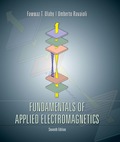
Concept explainers
A 2 kHz sound wave traveling in the x direction in air was observed to have a differential pressure p(x, t) = 10 N/m2 at x = 0 and t = 50 μs. If the reference phase of p(x, t) is 36°, find a complete expression for p(x, t). The velocity of sound in air is 330 m/s.
The complete expression for differential pressure
Answer to Problem 1P
The complete expression for
Explanation of Solution
Given data:
The differential pressure
The reference phase of
The velocity of the sound in air is
The frequency of the sound wave is
Calculation:
The formula to calculate the angular frequency is given as,
Here,
f is frequency of the sound wave and
Substitute
The formula for the wavelength of the sound wave is given as,
Here,
Substitute
The formula for the phase constant is given as,
Here, the phase constant is
Substitute
The expression for the differential pressure is given as follows.
Here,
Substitute
Further solving the above expression as,
Substitute
Conclusion:
Therefore, the complete expression for
Want to see more full solutions like this?
Chapter 1 Solutions
Fundamentals of Applied Electromagnetics (7th Edition)
- NO AI. Thank Youarrow_forwardPlease solve in detailarrow_forwardHere the Req is 8 my prof solved it and got R3 is parallel to R4 in series with R2 and this combination is parallel to R1. i don't understand how he got these relationships. initially i did the opposite i took (R1//R4 + R2 ) + R3 but got the wrong answer why is it wrong? can you explain to me if there's a trick i can do to understand these questions better and know the configurations of the resistors in a better manner?arrow_forward
- Here the Req is 8 my prof solved it and got R3 is parallel to R4 in series with R2 and this combination is parallel to R1. i don't understand how he got these relationships. initially i did the opposite i took (R1//R4 + R2 ) + R3 but got the wrong answer why is it wrong? can you explain to me if there's a trick i can do to understand these questions better and know the configurations of the resistors in a better manner?arrow_forwardThe ROC of Laplace transform of x(t) = -e²u(t) + e02tu(t) + e.tu(t) is a) 0.1 0.2arrow_forwardFind the inverse Laplace transform of F(s) = s+1 (s-1)(s-2)(s-3) for each ROC: i) Re[s] =>3 ii) Re[s] =σ<1 iii) 1 < Re[s] =σ< 2.arrow_forward
- Find Laplace transform of x(t) = −e¯btu(−t) + e¯atu(t) (), and Rocarrow_forwardPlease solve in detailarrow_forwardA left-sided signal x(t)=-e¯bt u(-t): 0 == X(s) -e-bu(t)e-st dt =- -Le-c 1 -(b+o+jw)t dt = = -00 -∞ (a + b) + jw 1 s+b For this integral to converge, it is necessary that b +σ <0; i.e., ROC: Re[s]=σ < −b. 2 How ?arrow_forward
 Introductory Circuit Analysis (13th Edition)Electrical EngineeringISBN:9780133923605Author:Robert L. BoylestadPublisher:PEARSON
Introductory Circuit Analysis (13th Edition)Electrical EngineeringISBN:9780133923605Author:Robert L. BoylestadPublisher:PEARSON Delmar's Standard Textbook Of ElectricityElectrical EngineeringISBN:9781337900348Author:Stephen L. HermanPublisher:Cengage Learning
Delmar's Standard Textbook Of ElectricityElectrical EngineeringISBN:9781337900348Author:Stephen L. HermanPublisher:Cengage Learning Programmable Logic ControllersElectrical EngineeringISBN:9780073373843Author:Frank D. PetruzellaPublisher:McGraw-Hill Education
Programmable Logic ControllersElectrical EngineeringISBN:9780073373843Author:Frank D. PetruzellaPublisher:McGraw-Hill Education Fundamentals of Electric CircuitsElectrical EngineeringISBN:9780078028229Author:Charles K Alexander, Matthew SadikuPublisher:McGraw-Hill Education
Fundamentals of Electric CircuitsElectrical EngineeringISBN:9780078028229Author:Charles K Alexander, Matthew SadikuPublisher:McGraw-Hill Education Electric Circuits. (11th Edition)Electrical EngineeringISBN:9780134746968Author:James W. Nilsson, Susan RiedelPublisher:PEARSON
Electric Circuits. (11th Edition)Electrical EngineeringISBN:9780134746968Author:James W. Nilsson, Susan RiedelPublisher:PEARSON Engineering ElectromagneticsElectrical EngineeringISBN:9780078028151Author:Hayt, William H. (william Hart), Jr, BUCK, John A.Publisher:Mcgraw-hill Education,
Engineering ElectromagneticsElectrical EngineeringISBN:9780078028151Author:Hayt, William H. (william Hart), Jr, BUCK, John A.Publisher:Mcgraw-hill Education,





